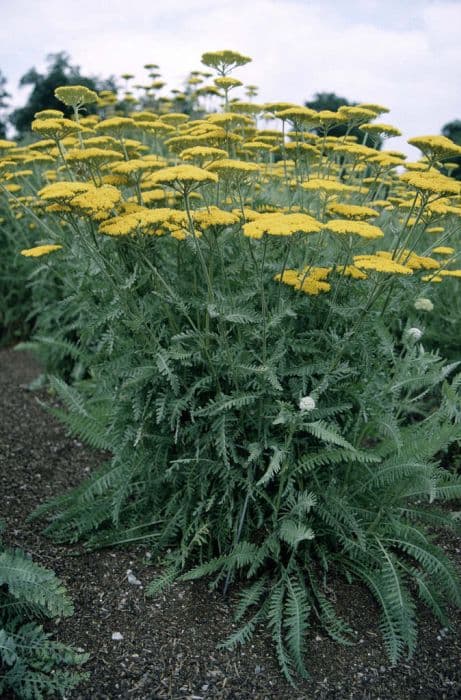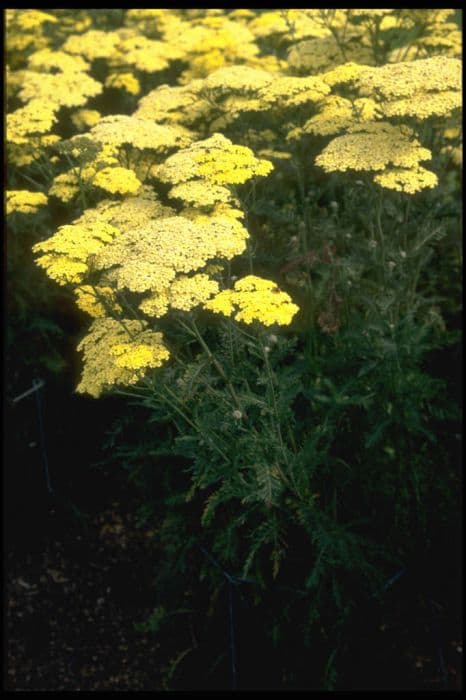Italian Aster Aster amellus 'Gründer'

ABOUT
Aster amellus 'Gründer' is a perennial plant known for its attractive and colorful daisy-like flowers. The blooms are typically a rich violet-blue shade with golden yellow centers that stand out against the plant's foliage. Each flower comprises numerous slender petals that radiate from the center, creating a classic aster shape that is beloved by gardeners. The leaves of the 'Gründer' variety are often lance-shaped, with a smooth texture, and they boast a deep green color. They are arranged alternately along the sturdy stems, which give the plant a structured and dense appearance. As the plant matures, it develops a bushy form with healthy foliage that serves as an excellent backdrop for the vivid flowers. The 'Gründer' can have multiple flowering stems, which creates a delightful mass of blooms when the plant is at its peak blooming period. This abundance of flowers is very attractive to pollinators such as bees and butterflies, making the 'Gründer' a valuable addition to any garden aiming to support local wildlife. Resilient in various conditions, this plant showcases a hardy nature, allowing it to thrive in a range of environments with proper care. It is also favored for its potential to provide lasting interest in the landscape, as it can retain its appealing aesthetic from late summer into fall, extending the garden's visual appeal deeper into the growing season. The Aster amellus 'Gründer' is a cherished choice for borders, garden beds, and as a part of mixed perennial plantings, where its striking color and charming form can be appreciated to the fullest.
About this plant
 Names
NamesFamily
Asteraceae
Synonyms
Italian Aster, European Michaelmas Daisy
Common names
Aster amellus 'Gründer'.
 Toxicity
ToxicityTo humans
The Italian aster (Aster amellus 'Gründer') is not known to be toxic to humans. However, like with many plants, individual allergies or sensitivities could potentially cause mild irritation if the plant is handled or ingested. It is always prudent to avoid ingesting parts of ornamental plants due to the possibility of individual reactions or the presence of garden chemicals.
To pets
Italian aster (Aster amellus 'Gründer') is not typically listed as toxic to pets such as cats and dogs. Nonetheless, ingestion of plant material can sometimes lead to gastrointestinal upset in some animals, even from plants that are not considered poisonous. It is always a good practice to monitor pets and discourage them from chewing on ornamental plants.
 Characteristics
CharacteristicsLife cycle
Perennials
Foliage type
Deciduous
Color of leaves
Green
Flower color
Blue
Height
1-2 feet (30-60 cm)
Spread
1-2 feet (30-60 cm)
Plant type
Herb
Hardiness zones
5
Native area
Europe
Benefits
 General Benefits
General Benefits- Attracts Pollinators: The vibrant flowers of Aster amellus, commonly known as Italian Aster, are known to attract bees, butterflies, and other beneficial pollinators, aiding in the pollination of plants and supporting local ecosystems.
- Low Maintenance: Italian Aster is relatively drought-tolerant and can thrive with minimal care, making it an excellent choice for gardeners seeking low-maintenance plants.
- Long Blooming Season: Italian Aster has a lengthy blooming period, typically from late summer into fall, providing a long-lasting display of color in the garden.
- Landscape Design: With its bright flowers and attractive foliage, Italian Aster is often used in borders, rock gardens, and as a cut flower in floral arrangements due to its aesthetic appeal.
- Wildlife Habitat: By providing nectar and pollen, Italian Aster supports wildlife, offering a habitat and food source for various insects and small animals.
- Erosion Control: The root system of Italian Aster helps to reduce soil erosion, making it a practical choice for sloped areas in the landscape.
- Plant Community: Italian Aster can be an integral part of a plant community, helping to establish diverse and resilient plant interactions in a garden or naturalized area.
 Medical Properties
Medical PropertiesThis plant is not used for medical purposes.
 Air-purifying Qualities
Air-purifying QualitiesThis plant is not specifically known for air purifying qualities.
 Other Uses
Other Uses- The Italian aster can be used as a natural fabric dye, producing varying shades of color depending on the mordant used.
- Italian aster can be part of a natural dye garden, which is planted specifically to harvest plants that yield pigments for dying fabrics and yarns.
- The vibrant flowers of the Italian aster can be used in crafts such as potpourri or dried flower arrangements, offering visual appeal and longevity.
- Italian aster's flowers can serve as decorative cake toppers for garden-themed cakes due to their edible petals, although they should be used sparingly and with caution because not all guests might be familiar with edible flowers.
- The Italian aster can attract beneficial insects such as ladybugs and lacewings to the garden, which can help control pest populations naturally.
- Italian asters can be used in photography to create a vivid and natural backdrop or for botanical illustration purposes, providing an aesthetically pleasing subject.
- The spent Italian aster blooms can be added to compost as a green material, contributing to the composting process and eventually providing nutrients back to the garden.
- Italian aster seeds can be involved in educational projects about the life cycle of plants and pollinator attraction, providing a hands-on learning experience.
- Dried Italian aster stems can be used in eco-friendly crafting, such as making homemade paper or creating woven art pieces.
- Italian aster can be used in sensory gardens for their texture and colorful aesthetics, providing an interactive experience for visitors, especially those with visual impairments.
Interesting Facts
 Feng Shui
Feng ShuiThe Italian Aster is not used in Feng Shui practice.
 Zodiac Sign Compitability
Zodiac Sign CompitabilityThe Italian Aster is not used in astrology practice.
 Plant Symbolism
Plant Symbolism- Patience: Asters are often associated with patience due to their late blooming, reminding us to persevere.
- Elegance: With its delicate petals and graceful form, Aster amellus 'Gründer' symbolizes a refined beauty.
- Wisdom: In some folklore, asters are believed to hold the wisdom of the ages, representing deep knowledge.
- Love of Variety: The array of colors in asters celebrates diversity and the enjoyment of many aspects of life.
 Water
WaterItalian asters should be watered regularly but with caution to avoid waterlogging. They prefer moist soil, so aim to water them once a week with about one to two gallons of water, depending on the local climate and soil drainage. During hot or dry spells, you may need to water more frequently. Always check the soil moisture an inch below the surface; if it feels dry, it's time to water. In winter, reduce watering as the plant requires less moisture during its dormant phase.
 Light
LightItalian asters thrive best in full sun conditions, receiving at least 6 to 8 hours of direct sunlight daily. They can tolerate light shade, but too much shade can impact their blooming and overall health. A sunny spot in your garden or near a south-facing window is ideal to provide the necessary light for optimum growth.
 Temperature
TemperatureItalian asters perform well in a wide range of temperatures but prefer a moderate climate. They can tolerate temperatures down to 20°F and are hardy in zones 4 through 8. Ideally, maintain a temperature between 65°F and 75°F for optimal growth. They should be planted in an area protected from harsh winds that could damage the plant during colder months.
 Pruning
PruningPrune Italian asters to maintain their shape, promote bushier growth, and encourage more blooms. The best time for pruning is early spring when new growth begins to emerge. Cut back old growth to about one-third of the plant's size, and remove any dead or damaged stems. Deadheading spent flowers regularly throughout the blooming season will also promote continuous flowering.
 Cleaning
CleaningAs needed
 Soil
SoilItalian Aster prefers well-draining soil with plenty of organic matter. A mix containing loam, peat, and sand in equal proportions creates an ideal growing medium. The soil pH should be slightly acidic to neutral, ranging from 6.0 to 7.5 for optimal growth.
 Repotting
RepottingItalian Aster does not require frequent repotting and can be replanted every 2 to 3 years. It's best to repot in the spring before the onset of new growth.
 Humidity & Misting
Humidity & MistingItalian Aster thrives in moderate humidity levels but is quite adaptable and can tolerate the typical humidity levels found outdoors in its growing zones.
 Suitable locations
Suitable locationsIndoor
Place in bright, indirect light with good air circulation.
Outdoor
Full sun, well-drained soil, and adequate spacing.
Hardiness zone
4-8 USDA
 Life cycle
Life cycleThe life of Aster amellus 'Gründer', commonly known as the Italian Aster or European Michaelmas Daisy, begins as a seed which germinates in spring, requiring well-draining soil and adequate sunlight. It develops a rosette of basal leaves and then a robust root system. As it matures, usually in the first or second year, the plant produces flowering stems during late summer to fall, which are adorned with daisy-like flowers that are attractive to pollinators. After blooming, the flowers produce seeds that are dispersed by wind or wildlife, completing the reproductive cycle. In the winter, the above-ground portion of the plant dies back, but the perennial root system remains alive to regenerate the next spring. With each season, the plant can grow larger and produce more flowering stems, contributing to its spread within its growing environment.
 Propogation
PropogationPropogation time
Spring-Early Summer
Aster amellus 'Gründer', commonly known as the European Michaelmas Daisy, is often propagated by division, which is the most popular method for propagating this perennial. The best time for this is in the early spring as the plant emerges from dormancy or in the late fall when the plant has finished flowering and is going dormant. To propagate by division, carefully lift the plant from the soil with a shovel, ensuring a generous amount of roots remain attached. The plant clump should then be gently pulled apart into smaller sections, each with several shoots and a healthy portion of roots. These divisions can then be replanted at the same depth they were originally growing, spaced about 18 inches (approximately 45 centimeters) apart to allow for growth and airflow between the plants. This method rejuvenates older clumps, promotes healthy growth, and can rapidly increase the number of plants in a garden.









